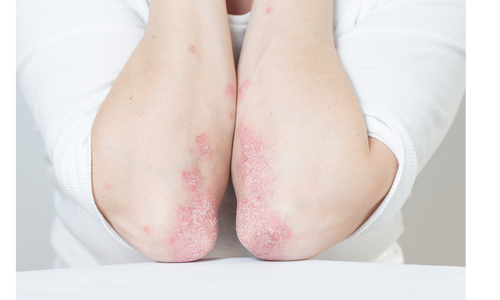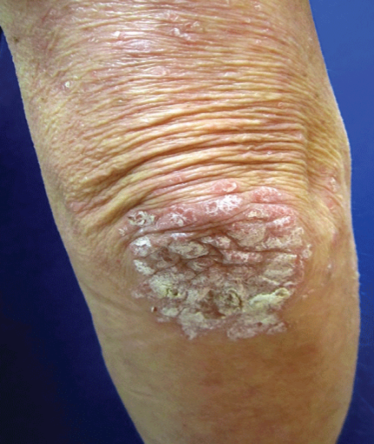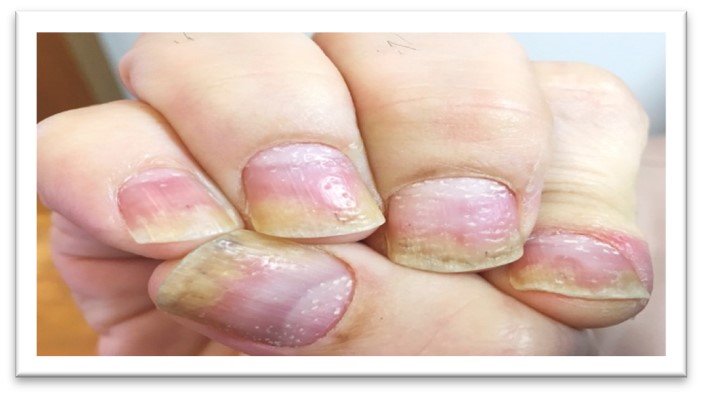
Psoriasis is a disease that is common in society and lasts for a long time with exacerbations. It is usually distinguished by sharply bordered rashes with psoriasis (silver) colored dandruff (flaking) on it, which gives its name to the disease. It is a chronic disease that occurs on the basis of hereditary or acquired triggering factors.
*It is seen as frequently as 1-3% in the society.
*It can affect the skin, nails and joints.
*It is most commonly observed on the scalp, knees, elbows and trunk. It appears as reddened, thick dandruff plaques with sharp borders. Although it can be seen at any age, it most commonly has two peaks between the ages of 20-30 and 50-60. In individuals with genetic predisposition, triggering factors such as trauma, sunlight, infections, endocrinological diseases, stress, drugs, alcohol and smoking play a role.
Today, it has been determined that psoriasis is associated with many diseases such as heart disease, fatty liver, obesity, diabetes, hypertension and high cholesterol.
What are the symptoms of your disease?
The symptoms of the disease vary according to its clinical features.
*Psoriasis vulgaris (plaque type psoriasis) It is the most common psoriasis clinic (80%). Typical symptoms are oval or round, raised skin rashes covered with silver-colored scales. It is frequently found on the knees, elbows, scalp and coccyx. Sometimes it occurs in the armpit, groin, under the breast, between the hips, behind the knee, inside the elbow. face It can also settle in folds such as the neck and neck (Inverse psoriasis). It can be seen on the palms and soles of the feet (Palmoplantar psoriasis)
*Guttate psoriasis Small, round, pink-red, dandruff-like bumps that resemble raindrops can be seen on the upper half of the body, arms and legs. ;r. It is common in children and adolescents. It usually occurs following a throat infection and lasts for a few days. It regresses within weeks or months.
* Erythrodermic psoriasis The disease covers more than 90% of the body. The disease may become widespread due to the influence of triggering factors such as drugs, sunlight, trauma, and infection. Treatment should be administered in the hospital.
*Pustular psoriasis There are pus-filled pimples on a red surface. Over typical psoriasis plaques or with a solid appearance. It occurs on the skin. It can be widespread throughout the body (diffuse pustular psoriasis) or localized to the palms and soles of the feet (palmoplantar pustular psoriasis).
*Psoriasis of the joints (psoriatic arthritis)It occurs in 2 out of every 10 patients and occurs in the 40s. Finger and waist joints are most commonly affected. It causes symptoms such as morning stiffness or stiffness that develops after sitting or standing for a long time, and swelling in the fingers or toes (a "sausage finger" appearance). Nail involvement is also common in joint involvement. It is usually accompanied by skin symptoms of the disease.
*Nail changes in psoriasis: Nails are affected in approximately 50% of patients. It causes complaints such as inability to use hands comfortably, pain and psychological stress. Pinhead-sized pitting on the nail surface, separation of the nail from its bed (onycholysis), yellowish discoloration under the nail (oil stain appearance), damage to one part of the nail. Loss of nail size and thickening of the skin under the free part of the nail are common changes.
What is the course of psoriasis?
*It is usually long-lasting, with exacerbations and periods of remission. The symptoms and severity of the disease may vary from person to person and even within the same person over time. Does pregnancy affect the course of the disease? A psoriasis patient can become pregnant. The impact of pregnancy is variable; The disease usually improves during pregnancy and returns to its previous course with attacks after birth. Pustular psoriasis may develop during pregnancy in a small number of patients. The medicines that can be used during pregnancy and breastfeeding should be asked to the doctor.
How is psoriasis diagnosed?
*Diagnosis can be made with clinical findings. Rarely, a skin biopsy may be required.
How is psoriasis treated?
There is no definitive treatment for the disease. However, it can be controlled with appropriate treatment and long-term well-being can be achieved. The physician, the patient and the patient's relatives should cooperate in the treatment.
*Drugs and behaviors that may exacerbate the disease (scratching, rubbing in the bath, scrubbing, etc.) should be avoided.
*In limited involvement psoriasis, local treatments are primarily chosen (drugs that remove dandruff on the skin surface, cortisone drugs, anthralin, calcipotriol [synthetic vitamin D], calcinerin inhibitors). These methods can also be used together.
*In resistant, widespread disease, methotrexate, cyclosporin-A, acitretin (synthetic vitamin A) and phototherapy are used. If there is no response to these, biological agents (adalimumab, etanercept, infliximab, ustekinumab, etc.) can be chosen.
*Many factors are effective in the choice and duration of treatment (extent of the disease, location, nail and joint involvement, etc.).
The psychological effects of the disease directionü, bad Due to its reputation, the fact that every disease can be confused with psoriasis, and the susceptibility of patients to suggestion, patients can unfortunately be exploited by claiming that psoriasis is treated by various centers. The patient's compliance with the recommended treatment is as important to the success of the treatment as your doctor's knowledge and experience about the disease. Therefore, do not use any treatment method that is not recommended by your doctor.
*Dr. Burcu Demirdöver has many researches on psoriasis and its association with metabolic diseases, which is also her subject of expertise thesis.





